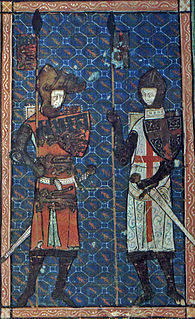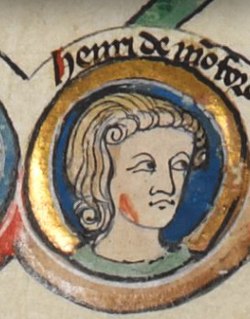 W
WNicholas de Crioll, of a family seated in Kent, was Constable of Dover Castle and Keeper of the Coast during the early 1260s. His kinsman Bertram de Criol had distinguished himself in these offices during the preceding 20 years and both were near predecessors of the eminent Warden of the Cinque Ports, Stephen de Pencester.
 W
WEdmund Crouchback, Earl of Lancaster, Leicester, and Derby was a member of the House of Plantagenet. He was the second surviving son of King Henry III of England and Eleanor of Provence. In his childhood he had a claim on the Kingdom of Sicily; however, he never ruled there. He was granted all the lands of Simon de Montfort in 1265, and from 1267 he was titled Earl of Leicester. In that year he also began to rule Lancashire, but he did not take the title Earl of Lancaster until 1276. Between 1276 and 1284 he governed the counties of Champagne and Brie with his second wife, Blanche of Artois, in the name of her daughter Joan, and he was described in the English patent rolls as earl of Lancaster and Champagne. His nickname, "Crouchback", may be a corruption of 'crossback' and refer to his participation in the Ninth Crusade.
 W
WJohn Botetourt, 1st Baron Botetourt was an English military commander and admiral in the 13th and 14th centuries.
 W
WRichard de Grey of Codnor, Derbyshire, was a landowner who held many important positions during the reign of Henry III of England, including Warden of the Isles 1226–1227, 1229–1230 and 1252–1254, and later both Constable of Dover Castle and Warden of the Cinque Ports from 1258 irregularly to 1264.
 W
WWilliam of Huntingfield was a medieval English baron, Sheriff of Norfolk and Suffolk and one of the Magna Carta sureties.
 W
WSir Roger de Leybourne (1215–1271) was an English soldier, landowner and royal servant during the Second Barons' War.
 W
WSir Henry de Montfort was the son of Simon de Montfort, 6th Earl of Leicester, and with his father played an important role in the struggle of the barons against King Henry III. Henry's mother was Princess Eleanor of England, a daughter of King John, whose marriage to Simon further increased the foreign influence begun by the king, which was to result in great hostility by those very barons who later revolted against the king.
 W
WNicholas de Moels or Nicholas Molis of North Cadbury in Somerset, was an Anglo‑Norman royal administrator and household knight of King Henry III. In this capacity he was assigned many and varied offices and duties, often of a temporary nature. He married a wealthy heiress which transformed him into a major landholder and feudal baron. In 1244 whilst serving as Seneschal of Gascony, he inflicted a defeat on the King of Navarre whom he took prisoner in the field.
 W
WStephen de Pencester was Warden of the Cinque Ports when the first authoritative list of Cinque Ports Confederation Members was produced in 1293.
 W
WAdmiral Sir William de Leybourne, was an English Knight and Military Commander.
 W
WWilliam of Wrotham or William de Wrotham was a medieval English royal administrator and clergyman. Although a late 13th-century source says that William held a royal office under King Henry II of England, the first contemporary reference to William is in 1197, when he became responsible for, among other things, the royal tin mines. He also held ecclesiastical office, eventually becoming Archdeacon of Taunton, and served King John of England as an administrator of ecclesiastical lands and a collector of taxes.